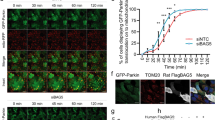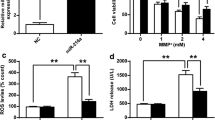Abstract
Bcl-2-associated athanogene 2 (BAG2) is an important member in the BAG family which is characterized by their property of interaction with a variety of partners involved in modulating the proliferation/death balance. The role of BAG family proteins in Parkinson’s disease (PD) has not been elucidated. In this study, we demonstrated that overexpressing BAG2 ameliorates the effects of 1-methyl-4-phenylpyridinium (MPP+) in mitochondrial membrane potential (MMP) collapse, reactive oxygen species (ROS) generation, and mitochondrial release of cytochrome C. However, knockdown of DJ-1 abolished the neuroprotective effects of BAG2 against MPP+-induced neuronal toxicity. With co-immunoprecipitation and pulldown experiments, we present a direct physical interaction between BAG2 and DJ-1. Co-expression of BAG-2 together with DJ-1 increased the ratio of dimer/monomer staining intensity at the basal level. Our results indicated that MPP+ treatment leads to the disassociation of the homodimer of DJ-1. When BAG2 was overexpressed in cells, the homodimer of DJ-1 was increased. Importantly, BAG2 prevents MPP+-induced monomerization of DJ-1. Thus, our data showed that the neuroprotective effects of BAG2 are mediated by its interaction with DJ-1, strengthening the link between the BAG proteins and PD-related neurodegeneration.




Similar content being viewed by others
References
Arndt V, Daniel C, Nastainczyk W, Alberti S, Hohfeld J (2005) BAG-2 acts as an inhibitor of the chaperone-associated ubiquitin ligase CHIP. Mol Biol Cell 16:5891–5900
Bandopadhyay R, Kingsbury AE, Cookson MR et al (2004) The expression of DJ-1 (PARK7) in normal human CNS and idiopathic Parkinson’s disease. Brain 127:420–430
Bekris LM, Mata IF, Zabetian CP (2010) The genetics of Parkinson disease. J Geriatr Psychiatry Neurol 23(4):228–242
Bonifati V, Rizzu P, van Baren MJ, Schaap O, Breedveld GJ, Krieger E et al (2003) Mutations in the DJ-1 gene associated with autosomal recessive early-onset parkinsonism. Science 299:256–259
Carrettiero DC, Hernandez I, Neveu P, Papagiannakopoulos T, Kosik KS (2009) The cochaperone BAG2 sweeps paired helical filament-insoluble tau from the microtubule. J Neurosci 29:2151–2161
Che X, Tang B, Wang X, Chen D, Yan X, Jiang H, Shen L, Xu Q, Wang G, Guo J (2013) The BAG2 protein stabilises PINK1 by decreasing its ubiquitination. Biochem Biophys Res Commun 441(2):488–492
Chen CY (2012) Mechanism of BAG1 repair on Parkinson’s disease-linked DJ-1 mutation. J Biomol Struct Dyn 30(1):1–12
Chung KK, Dawson TM (2004) Parkin and Hsp70 sacked by BAG5. Neuron 44:899–901
Deeg S, Gralle M, Sroka K, Bähr M, Wouters FS, Kermer P (2010) BAG1 restores formation of functional DJ-1 L166P dimers and DJ-1 chaperone activity. J Cell Biol 188:505–513
Elliott E, Tsvetkov P, Ginzburg I (2007) BAG-1 associates with Hsc70 Tau complex and regulates the proteasomal degradation of Tau protein. J Biol Chem 282:37276–37284
Goldberg MS, Pisani A, Haburcak M et al (2005) Nigrostriatal dopaminergic deficits and hypokinesia caused by inactivation of the familial Parkinsonism-linked gene DJ-1. Neuron 45:489–496
Honbou K, Suzuki NN, Horiuchi M, Niki T, Taira T, Ariga H, Inagaki F (2003) The crystal structure of DJ-1, a protein related to male fertility and Parkinson’s disease. J Biol Chem 278:31380–31384
Kabbage M, Dickman MB (2008) The BAG proteins: a ubiquitous family of chaperone regulators. Cell Mol Life Sci 65:1390–1402
Kalia LV, Kalia SK, Chau H, Lozano AM, Hyman BT, McLean PJ (2011) Ubiquitinylation of a-synuclein by carboxyl terminus Hsp70-interacting protein (CHIP) is regulated by Bcl-2-associated athanogene 5 (BAG5). PLoS One 6:e14695
Kinumi T, Kimata J, Taira T, Ariga H, Niki E (2004) Cysteine-106 of DJ-1 is the most sensitive cysteine residue to hydrogen peroxide-mediated oxidation in vivo in human umbilical vein endothelial cells. Biochem Biophys Res Commun 317:722–728
Liman J, Sroka K, Dohm CP, Deeg S, Bähr M et al (2010) Modulation of huntingtin toxicity by BAG1 is dependent on an intact BAG domain. Molecules 15:6678–6687
Maita C, Maita H, Iguchi-Ariga SM, Ariga H (2013) Monomer DJ-1 and its N-terminal sequence are necessary for mitochondrial localization of DJ-1 mutants. PLoS One 8(1):e54087
Meulener M, Whitworth AJ, Armstrong-Gold CE, Rizzu P, Heutink P, Wes PD, Pallanck LJ, Bonini NM (2005) Drosophila DJ-1 mutants are selectively sensitive to environmental toxins associated with Parkinson’s disease. Curr Biol 15:1572–1577
Nollen EAA, Brunsting JF, Song J, Kampinga HH, Morimoto RI (2000) Bag1 functions in vivo as a negative regulator of Hsp70 chaperone activity. Mol Cell Biol 20:1083–1088
Sheng B, Niu Y, Zhou H, Yan J, Zhao N, Zhang X, Gong Y (2009) The mitochondrial function was impaired in APP knockout mouse embryo fibroblast cells. Chin Sci Bull 54:1725–1731
Sheng B, Wang X, Su B et al (2012) Impaired mitochondrial biogenesis contributes to mitochondrial dysfunction in Alzheimer’s disease. J Neurochem 120:419–429
Taira T, Saito Y, Niki T, Iguchi-Ariga SM, Takahashi K, Ariga H (2004) DJ-1 has a role in antioxidative stress to prevent cell death. EMBO Rep 5(2):213–218
Takayama S, Reed JC (2001) Molecular chaperone targeting and regulation by BAG family proteins. Nat Cell Biol 3:E237–E241
Takayama S, Bimston DN, Matsuzawa S, Freeman BC, Aime-Sempe C, Xie Z et al (1997) BAG-1 modulates the chaperone activity of Hsp70/Hsc70. EMBO J 16:4887–4896
Acknowledgments
Shandong Province medicine and health science and technology development project, 2013WSB02001
Author information
Authors and Affiliations
Corresponding author
Rights and permissions
About this article
Cite this article
Song, Z., Xu, S., Song, B. et al. Bcl-2-Associated Athanogene 2 Prevents the Neurotoxicity of MPP+ via Interaction with DJ-1. J Mol Neurosci 55, 798–802 (2015). https://doi.org/10.1007/s12031-014-0481-6
Received:
Accepted:
Published:
Issue Date:
DOI: https://doi.org/10.1007/s12031-014-0481-6




